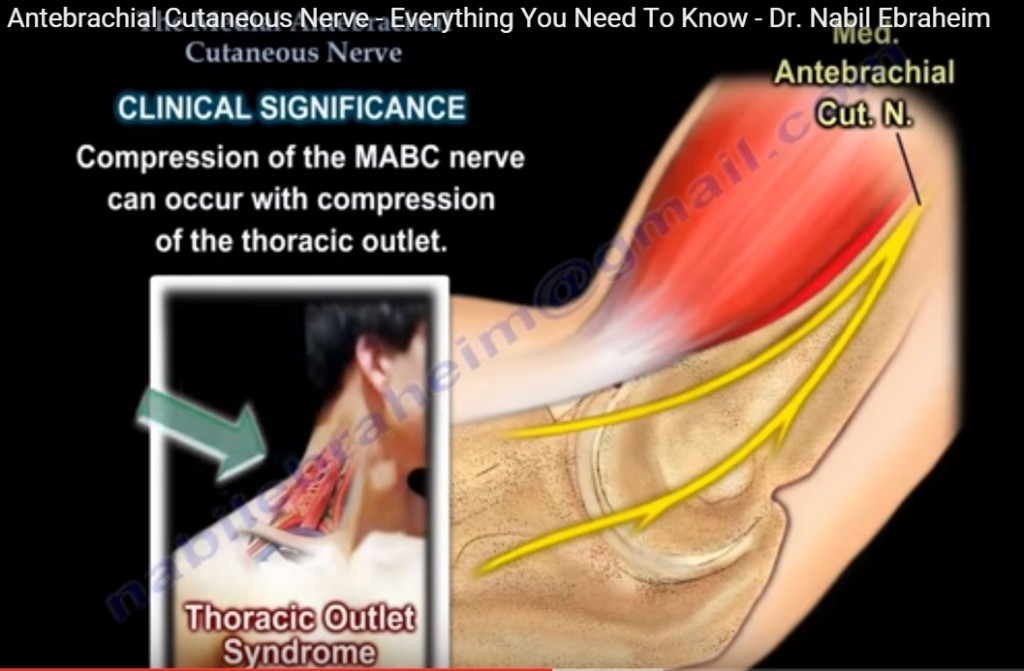Courtesy: Prof Nabile Ebraheim, University of Toledo, Ohio, USA
- Anatomy, course and distribution of the medial antebrachial cutaneous nerve is vague.
- Clinical knowledge of the anatomy of this nerve is valuable.
- Due to its anatomical course, this nerve may become easily injured.
- Innervation (C8, T1): Just before the formation of the ulnar nerve, the medial cord of the brachial plexus gives two branches: 1- the medial brachial cutaneous nerve and 2- the medial antebrachial cutaneous nerve.
- The medial antebrachial cutaneous nerve: The medial antebrachial cutaneous nerve innervates the skin of the anterior and medial surface of the forearm as far down to the palmar side of the wrist.
- The area of innervation is indicated on the diagram, the volar side to the right, and the dorsal side is to the left. It also innervates the medial and posterior side of the elbow area.
- The medial antebrachial cutaneous nerve descends in the arm anterior and medial to the brachial artery.
- It lies on the ulnar side of the biceps muscle before running distally.
- The medial antebrachial cutaneous nerve usually branches into two nerves: the anterior branch and the posterior branch just proximal and anterior to the medial epicondyle.
- The branches of this nerve always originate medially and runs anterolaterally.
- The anterior branch runs along the anteromedial forearm and the posterior branch crosses the field of incision for decompression of the ulnar nerve.
- It is important to remember that the medial antebrachial cutaneous nerve runs adjacent to the basilica vein. Clinical significance:
- 1- The medial antebrachial cutaneous nerve is an available donor for nerve grafts, the anterior branch is harvested, two fingerbreadth anterior and distal to the medial epicondyle, and it is used as a graft for repair of traumatic defects greater than 1cm of the digital nerves. The anterior branch also used in nerve grafting especially in brachial plexus reconstruction.
- 2- Compression of the MABC nerve can occur with compression of the thoracic outlet.
- 3- Some people consider the MABC nerve to be part of the ulnar nerve and its sensory innervation is considered to be a proximal ulnar innervation.
- 4- Injury to the nerve can occur from surgical procedure in the medial or posterior side of the elbow. Injury may also occur due to steroid injection for the medial epicondylitis. Also care should be taken during venipuncture; the basilic vein is close to the MABC nerve.
- 5- Care should be taken when dissecting around the elbow, the skin incision should be altered to protect the nerve or the nerve should be identified, retracted and protected.
- Sacrifice of the posterior branch in the medial approach to the elbow or from cubital tunnel surgery can lead to numbness over the olecranon and to symptomatic neuroma, neuroma may need to be explored and buried.
- The standard incision used for surgery associated with the ulnar nerve at the elbow can cause injury of the terminal branches of this nerve, injury can also occur due to elbow arthroscopy.
- Differential diagnosis of neuromatosis from ulnar nerve symptoms: – Both the MABC and the ulnar nerve are in the same location and give the same symptoms, and can be hard to distinguish between them, you may want to use differential blocks, in addition to elaborate clinical exam. –
- When there is a sensory abnormality of an expected ulnar nerve injury extending more than 2cm proximal to the wrist crease, one should consider involvement of the MABC nerve, the medial cord, or the C8-T1 nerve roots.

Nice stuff